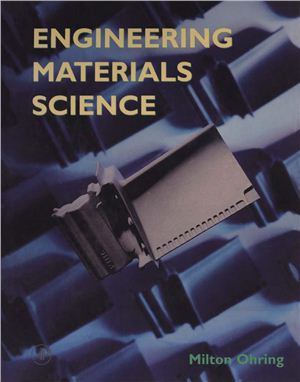Academic Press, 1995, 827 pages, ISBN: 0125249950
Milton Ohring's Engineering Materials Science integrates the scientific nature and mode applications of all classes of engineering materials. This comprehensive, introductory textbook will provide undergraduate engineering students with the fundamental background needed to understand the science of structure-property relationships, as well as address the engineering conces of materials selection in design, processing materials into useful products, andhow material degrade and fail in service. Specific topics include: physical and electronic structure; thermodynamics and kinetics; processing; mechanical, electrical, magnetic, and optical properties; degradation; and failure and reliability. The book offers superior coverage of electrical, optical, and magnetic materials than competing text.
The author has taught introductory courses in material science and engineering both in academia and industry (AT&T Bell Laboratories) and has also written the well-received book, The Material Science of Thin Films (Academic Press).
Key Features:
Provides a mode treatment of materials exposing the interrelated themes of structure, properties, processing, and performance.
Includes an interactive, computationally oriented, computer disk containing nine modules dealing with structure, phase diagrams, diffusion, and mechanical and electronic properties.
Fundamentals are stressed.
Of particular interest to students, researchers, and professionals in the field of electronic engineering.
Milton Ohring's Engineering Materials Science integrates the scientific nature and mode applications of all classes of engineering materials. This comprehensive, introductory textbook will provide undergraduate engineering students with the fundamental background needed to understand the science of structure-property relationships, as well as address the engineering conces of materials selection in design, processing materials into useful products, andhow material degrade and fail in service. Specific topics include: physical and electronic structure; thermodynamics and kinetics; processing; mechanical, electrical, magnetic, and optical properties; degradation; and failure and reliability. The book offers superior coverage of electrical, optical, and magnetic materials than competing text.
The author has taught introductory courses in material science and engineering both in academia and industry (AT&T Bell Laboratories) and has also written the well-received book, The Material Science of Thin Films (Academic Press).
Key Features:
Provides a mode treatment of materials exposing the interrelated themes of structure, properties, processing, and performance.
Includes an interactive, computationally oriented, computer disk containing nine modules dealing with structure, phase diagrams, diffusion, and mechanical and electronic properties.
Fundamentals are stressed.
Of particular interest to students, researchers, and professionals in the field of electronic engineering.

